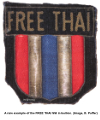|
insigne.org |
The
Free
Thai
by Les Hughes © 2002 by author
|
|
|
|
After Thailand fell to the Japanese, Thailand's leader, Field Marshall Phibun Songkhram, entered into an alliance with Japan that led to a declaration of war against the United States and Great Britain. This placed in something of a predicament the approximately 80 Thai students who were studying in the U.S. at the time. The feeling among the Thai students was that Japan was the aggressor and that ultimately the Allies would prevail. This sentiment was shared by the Thai minister in Washington, D.C., who ignored the instructions of the Thai government and proceeded to establish a Free Thai organization headquartered in his legation. A key goal of the Free Thai movement was to secure for Thailand credit for having fought the Japanese. To this end, 40 Thai students, many from prominent families, volunteered for service in OSS, in which they would serve together and retain a separate identity as Free Thai officers. Their identity as Free Thai troops was underscored by the fact their activities were financed by funds that the Thai government had on deposit in the U.S. at the outbreak of the war. After extensive training, the first group of Free Thai arrived in China in mid-1943 and quickly ran headlong into the political realities of the war in the CBI Theater and, especially, in Southeast Asia. Although China, Britain, and the United States were allied in their fight against Japan, each brought to the alliance its own agenda for shaping post-war Thailand. Adding to the problems deriving from conflicting interests among the Allies were ones deriving from conflicts among the Thai leadership and from inter-service turf wars within the America military. All of these problems frustrated the efforts of the Free Thai and rendered their effectiveness problematic. Individuals interested in the Free Thai are directed to the books of John B. Haseman and Wimon Wiriyawit. A sleeve patch (illustrated above) bearing the words FREE THAI has been known to collectors for decades, but beyond the obvious, that the patch is connected to a group calling themselves the Fee Thai, virtually nothing was known about the origin or the use of the patch. The example illustrated above was acquired by the author from a veteran of Detachment 101, who, 45 years later, could not recall how he had come to have it. I sent a photocopy of the patch to one of the American OSS officers assigned to work with the Free Thai, and he could not recall ever having seen the patch. And so when I first wrote about the insignia of the OSS, in 1993, there was little hard information about the patch that I could provide. Then, in 2000, Peter Bonner brought to my attention the book of Wimon Wiriyawit, who had served with the Free Thai. There are in Wiriyawit's book several photographs, all formal poses such as the one above, of Free Thai officers with the FREE THAI patch on their dress uniforms. I wrote to Wiriyawit to secure permission to use his photo, and I asked what he could tell me about the patch. They were given to the men, he said, while they were in Washington, DC. (The patches of Detachment 101 were made by a firm in that city.) Examining closely the other photos in Wiriyawit's book, I found no evidence of the patch in use except in these formal poses, which makes sense: the mission of these men, to infiltrate occupied Thailand, argued against wearing such an insigne. Here, however, is evidence that this is a patch that was issued and worn. References The Thai Resistance Movement During The Second World War, John B. Haseman, Chalermnit Press, Bangkok. Free Thai, compiled by Wimon Wiriyawit, White Lotus Co., Ltd, Bangkok, 1997. |


